

WWWJDIC: Verb Conjugation Display.
The Japanese Grammar database. Japanese culture: How many I's a japanese has? Japanese for the Western Brain. *** Notice *** If you would like to give money to support relief efforts in Japan, it is possible to donate directly to the Japanese Red Cross Society.
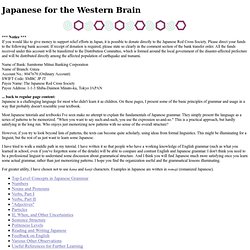
Please direct your funds to the following bank account. If receipt of donation is required, please state so clearly in the comment section of the bank transfer order. All the funds received under this account will be transferred to the Distribution Committee, which is formed around the local government of the disaster-affected prefecture and will be distributed directly among the affected population of earthquake and tsunami. Name of Bank: Sumitomo Mitsui Banking Corporation Name of Branch: Ginza Account No.: 8047670 (Ordinary Account) SWIFT Code: SMBC JP JT Payee Name: The Japanese Red Cross Society Payee Address: 1-1-3 Shiba-Daimon Minato-ku, Tokyo JAPAN ... back to regular page content:Japanese is a challenging language for most who didn't learn it as children.
I have tried to walk a middle path in my tutorial. JLPT Guide. Japanese Language Proficiency Test Before 2010, there were only 4 levels of the JLPT, and the test agency released official vocabulary and grammar lists.
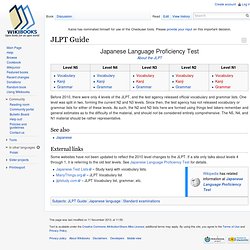
One level was split in two, forming the current N2 and N3 levels. Since then, the test agency has not released vocabulary or grammar lists for either of these levels. As such, the N2 and N3 lists here are formed using things test takers remember and general estimates as to the difficulty of the material, and should not be considered entirely comprehensive. The N5, N4, and N1 material should be rather representative. See also. _^ - lekcja 11. Japanese Verbs - Introduction and Table of Contents. Learn Japanese - Japanese Verb Conjugation. Japanese/Grammar/Verbs - Wikibooks, collection of open-content textbooks. Japanese verbs, (動詞; どうし), inflect heavily to indicate formality, tense or mood, primarily in their ending.
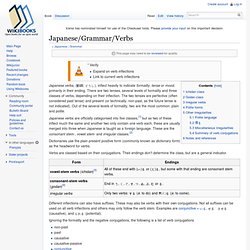
There are two tenses, several levels of formality and three classes of verbs, depending on their inflection. The two tenses are perfective (often considered past tense) and present (or technically, non-past, as the future tense is not indicated). Out of the several levels of formality, two are the most common: plain and polite. Japanese verbs are officially categorised into five classes,[1] but as two of these inflect much the same and another two only contain one verb each, these are usually merged into three when Japanese is taught as a foreign language. These are the consonant stem-, vowel stem- and irregular classes.[2] Dictionaries use the plain present positive form (commonly known as dictionary form) as the headword for verbs. Verbs are classed based on their conjugations.
Different inflections can also have suffixes. Ichidan class[edit] Godan class[edit] Irregular verbs[edit] Tae Kim's Guide to Learning Japanese. This guide was created as a resource for those who want to learn Japanese grammar in a rational, intuitive way that makes sense in Japanese.

The explanations are focused on how to make sense of the grammar not from English but from a Japanese point of view. Before you begin If your computer is not setup to display Japanese, you’ll want to enable Japanese support to read the Japanese text. Other formats Paperback – Available on Amazon.PDF Version – Philipp Kerling wrote an awesome script to convert the site to PDF.iOS app – The guide is now available for iOS devices created by Adam Critchley.Android app – The guide is now available on Google Play created by Ignatius Reza Lesmana. This work is released under a Creative Commons Attribution-Noncommercial-Share Alike License.
日本語資源 - Nihongoresources.com. Teach Yourself Japanese. Online Japanese Study. Preparation Hiragana character sets Hiragana input Katakana character sets Beginner guidance 01.names 02.interrogative sentences / negative sentences 03.numerals / age 04.demonstratives 05.a noun + a noun interviews 06.places the date and time 07.from A to B 08.verbs cities 09.the past form 10.already / yet / not yet Shall we counter list 11.counter counter list2 shopping 12.possessions interviews2 13.positions a map orders ≪ Diagnostic Test 1 ≫ Elementary.
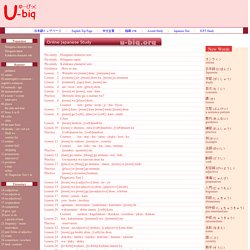
Maktos: Japanese Is Possible! JGram - The Japanese Grammar database. Japanese Language Free Study Material - MLC Japanese Language School. Japanese Language & Culture @ Epochrypha. One of the hardest aspects of mastering any language is mastering the words that change form by inflection.
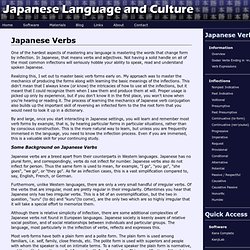
In Japanese, that means verbs and adjectives. Not having a solid handle on all of the most common inflections will seriously hobble your ability to speak, read and understand spoken Japanese. Realizing this, I set out to master basic verb forms early on. My approach was to master the mechanics of producing the forms along with learning the basic meanings of the inflections. This didn't mean that I always knew (or know) the intricacies of how to use all the inflections, but it meant that I could recognize them when I saw them and produce them at will.
By and large, once you start interacting in Japanese settings, you will learn and remember most verb forms by example, that is, by hearing particular forms in particular situations, rather than by conscious construction.